
In the village of Getsemani, Lisa Thomas, P’17, and I walk down a road of dirt and rock. The morning is warm, the landscape bright and lush. In the distance rise mountains covered in green.
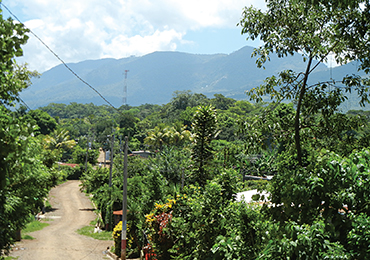
Photo: John Crawford
Wearing a Habitat for Humanity T-shirt with the word “voluntario” on the back, Thomas stops at a house that sits next to a hill full of corn. She’s wondering if anyone is home. Across the way, a small, nondescript store sells snacks and soda, and the proprietor looks out the window, waiting for customers.
Thomas, the director of Babson’s Office of Faith and Service, calls out to the people inside the house. Four years ago, she helped build an addition to the home and dig a hole for a septic system. She became friendly with the family who lives here, spending hours jumping rope with a little girl named Diana. Opening a gate made of sheet metal, Thomas walks into a yard, where a grandmother and mother are giving a bath to two toddlers in a basin. Diana, now 10 or 11 years old, approaches. “Hello. Remember me?” says Thomas. “We played lots of jump rope.” The two hug.

The greenery (top photo) and dirt roads of Getsemani.
Located in El Salvador near the Guatemalan border, Getsemani is hard to find on a map. Situated on land that once was a coffee plantation, it’s poor and tucked away, a place easily passed over, though roughly 1,000 people in the village and surrounding area call it home. To come to Getsemani is to see a community far removed from Wellesley and the U.S., not just in terms of miles but also in wealth and opportunity.
But here in this distant village, a hamlet that takes its name from the Bible, from the garden where Jesus prayed the night before his crucifixion, Babson has a history. The College first came to El Salvador in 2007, and, twice a year since 2010, teams have ventured to Getsemani. They come to build houses with Habitat, and they also come to teach about entrepreneurship and its transformative powers. They lift cinder blocks, talk about sales pitches and passions, and deal with bugs, mud, and sweat. In the quiet times, they reflect about the people of Getsemani, who live in poverty but hope for better.
An Eye-opening Ride
In El Salvador, what hits you first after stepping out of the airport is the heat. You sweat even when you’re not moving, and a good breeze feels like a small gift from the heavens. Southerner Derishai Gordon-Staton ’15 says, “It’s hotter than a Louisiana hot pepper in July.”
Gordon-Staton is one of four Babson students on the August trip, along with Nina Duong, Taelyr Roberts, and Alex Woodhouse, all ’15. The four have been involved with the Office of Faith and Service throughout their college careers, and they now manage many of its programs. They’re a tight-knit group. Not only do they work together, they cook, hang out, and take trips to the gym and supermarket together. “And now we’re in a different country together,” says Woodhouse. Also on the trip are four staff members (Thomas, co-leader Brian Duggan, MBA’05, Chris Bourcier, MBA’16, and myself). Friends and family are encouraged to take the trip as well, so Thomas’s nephew, 16-year-old Harrison Rohrer, came with two of his buddies, Juan Carlos Fernandez and Luke Sugrue. On the flight down, they dutifully read their assigned summer books.
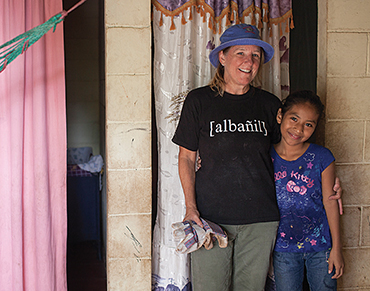
Lisa Thomas, P’17, director of the Office of Faith and Service, visits a family whose house she had worked on four years earlier. “This is a community I’ve become attached to,” Thomas says.
Arriving in El Salvador on a Saturday afternoon, the team first heads to an ocean resort to rest before the hard work in Getsemani begins. On the bus ride, the country passes by. Fruit stand after fruit stand line the road, as do signs advertising a Denny’s restaurant and Gana, a political party claiming to be “El Partido de Unidos.” Pickup trucks serve as makeshift buses, hauling passengers crammed together in the trucks’ beds. Standing as the trucks move, the riders hold on to a railing to keep from falling out.
We pass animals everywhere: cows, pigs, horses, and, especially, dogs. Chickens literally try to cross the road. In small towns we pass murals and markets, and in the countryside the scenery grows gorgeous, teeming with green. Far off, clouds touch the tops of mountains.
We can’t ignore the poverty. According to The World Factbook of the CIA, 36 percent of El Salvador’s 6.1 million residents live below the poverty line, and Habitat for Humanity says the average annual income is just under $2,500. We see many houses that are patched together with tarp, tree branches, palm leaves, and sheet metal. Some look like a strong wind would blow them over.
Habitat estimates that more than 500,000 Salvadorian families live in inadequate housing, a situation exacerbated by the country’s vulnerability to natural disasters. With hurricanes, earthquakes, and volcanic activity all plaguing the country, El Salvador stands in the cross hairs of the worst that Mother Nature has to offer.
As we ride on the bus, the students grow quiet. Partly, they’re tired from the trip. But Duggan, who has been to Getsemani with Babson multiple times, says this isn’t the first silent bus ride from the airport that he has experienced. “Many students may never have seen such poverty before,” says Duggan, who on campus is assistant class dean for first-year programs.
Suddenly, the Pacific Ocean appears in all its vastness and beauty, and we come upon the Rancho Estero Y Mar, our lodging for the night. The resort marks a stark contrast from the sights of the bus ride. It offers guests not only a beach by the ocean, but also kayaking, pool tables, and various pools. Parrots that live on the grounds squawk “hola” at you, and, strangely, the resort keeps four or five monkeys in a cage to entertain guests. A sign warns that the monkeys may scratch or bite.
As the Babson team eases out the day by the water, I ask the students about the bus ride and the poverty they saw. Duong answers me truthfully: “To be honest, it made me grateful to live where I am.” I can’t help but agree.
The next day, we head west.

Glenda Cadenas, 18, sells her jewelry in local markets and to volunteer teams passing through, though she has bigger ambitions. “I would love to send them to other countries so people can buy them abroad,” she says.
Arriving in the Village
For the rest of the trip, our base is the Segen Hostel, which is in the hilly town of Ataco, an amiable place with streets paved with cobblestones and stores that sell crafts from local artisans. From Ataco, it’s about a 25-minute bus ride to Getsemani.
By Monday morning, the team is eager to start work. For breakfast, the Segen serves orange juice, papaya, cantaloupe, and tasty pupusas, a thick tortilla stuffed with combinations of beans, cheese, and pork. Team members pull out their smartphones to check for a signal, which can be spotty, and a Britney Spears documentary plays on the hostel’s TV, though the satellite picture frequently breaks up.
Breakfast finished, we climb on the bus, which bounces over Ataco’s cobblestones as we head out of town. On the ride I sit next to Bourcier. For the past three years, he has served in the Office of Faith and Service as an AmeriCorps member, and now that his term is over, he’s joining the office’s staff as a full-time employee. Like others on the trip, Bourcier is driven by a need to have a positive influence on the world. Before AmeriCorps, he worked on political campaigns at both the local and national levels. “I enjoyed it at first,” he says, but eventually he left it behind. “I felt jaded by it. It was less impactful than I thought it would be.” At Babson and in Getsemani, Bourcier has found the direct and tangible work he was seeking.

Solidly constructed homes, like the one Babson is helping to build, are badly needed.
Initially, Babson’s efforts in Getsemani focused solely on building houses. But four years ago, as Thomas and the team spent hours digging a septic-system hole at the home of Diana and her family, they wondered if there were other ways to help. No doubt, a proper house is important. As Thomas says, “A home brings stability and dignity.” But Babson has expertise in entrepreneurship. What if team members shared that knowledge? How would that affect the village and its people?
So in addition to building houses, the Babson teams now consult with local businesspeople in a co-op. (During its March trip, the team also teaches idea generation to schoolchildren.) Nearly 70 people, running a variety of small enterprises, pay $4 a month to be part of the co-op. The Babson team works with entrepreneurs, mostly women, who make and sell jewelry, artwork, and garments. These woman went into business for the most practical of reasons: They needed extra money for their families. Their profits can buy additional food or allow them to save. Earning money also gives them hope and confidence. “They know they can aspire for more, and achieve it,” says Duggan.
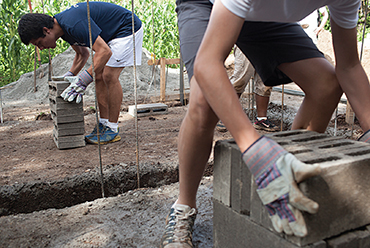
Habitat for Humanity estimates that about half of El Salvador’s population lives in substandard housing.
Upon arriving in Getsemani, we head to the village’s community center. There is no traffic, no morning rush. Not that the village is entirely quiet. It has its own sounds and rhythms. Walk around, and you’ll hear roosters crowing, babies crying, and music, always music, playing with either English or Spanish singers. From time to time, a tinkling of a bell can be heard from the ice cream man, who rings it while walking the village’s lanes carrying an ice chest full of treats. Inside the community center, the owner of the Habitat house being built, David Chavez, welcomes us to Getsemani. The 22-year-old works as a sales clerk in a pharmacy. When the new house is finished, he will live there with his parents. “It is a pleasure to have you in our community,” Chavez says. (He speaks in Spanish, and, as with all the village residents quoted in this story, these are his words through a translator.) “We hope you like our community and feel welcome.”
Our group then walks to the building site. To get there, we pass a cornfield and a soccer field, then cross a makeshift wooden bridge stretching over a stream, and then pass more corn. Along the way, we see the many Habitat houses that previous Babson teams and other volunteer groups have helped build. They have a standard look: cinder block walls, a tin roof, and a cozy size (the typical house is 450 square feet). In all, Habitat has constructed some 60 homes in Getsemani and its surrounding area.
When we arrive at the building site, two masons, Julio and Mario, already are working, putting up metal supports called rebar. The masons are in charge at the site, and, during the week, the Babson team will help them by moving cinder blocks, pouring the foundation, stirring chispa (a mix of cement, sand, gravel, and water), and constructing the walls. The work is dirty and sweaty. “We do whatever the masons tell us to do,” Thomas says. “They tell us to move blocks, we move blocks.”
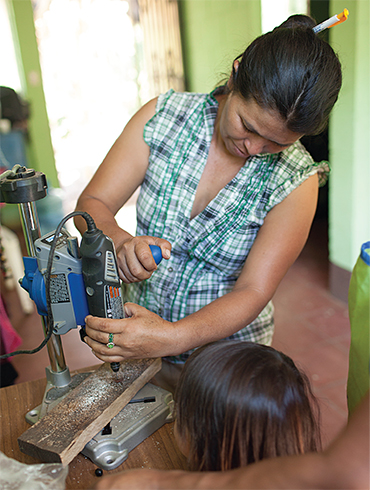
A Getsemani artisan uses a drill to put holes through coffee beans and other items, which she then strings together to make bracelets and necklaces.
The Ladies of the Co-op
While half of the team’s time will be spent at the building site, the other half is spent at the co-op. The co-op is located in a Habitat house, and we sit in the front yard under a canopy of palm leaves and tarp held up by bamboo poles. I’m thankful for the shade, though rainwater collects in the tarp and sometimes leaks down, leaving muddy puddles in the dirt.
As stray dogs continually wander through the co-op’s yard, the team members work with two groups of entrepreneurs. In the morning, they spend time with teenagers and young adults, and in the afternoon, the co-op leaders. During the initial sessions on Monday, team members ask each group lots of questions—about marketing, inventory, accounting, all sorts of things—to figure out how they can best help the entrepreneurs during the week.
Attending the morning session is Glenda Cadenas, 18. She started making necklaces, earrings, and bracelets because it was simply fun, but then she realized that selling her pieces could provide a little independence. “I wanted to buy some things, and I didn’t want to ask my parents for the money,” she says. Money also is on the mind of Jacqueline Decena, 20. She’s married, and her husband works as a mason’s assistant. Decena knits scarves and pouches, but she wants to learn how to use a sewing machine so she can make a greater variety of items, like aprons, quilts, and place mats. “We have a need to make more money,” she says.
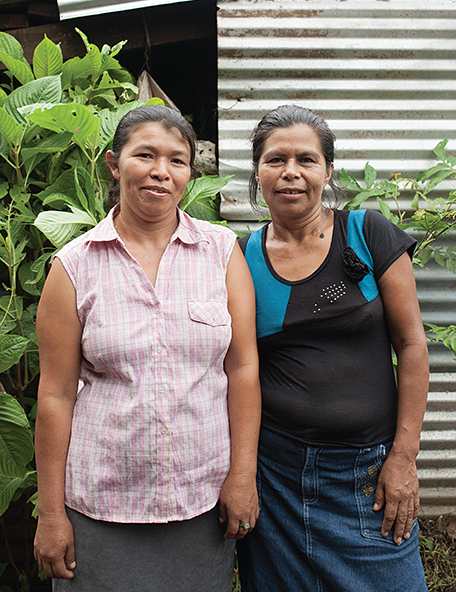
Betty Cadenas (left) and Juana Romero (right) are two of the leaders of the Getsemani co-op, which offers low-interest loans to entrepreneurs. “We don’t make loans to make a profit,” Cadenas says. “People know the co-op is here to help them.”
The Babson team decides to work on sales pitches with the young entrepreneurs and runs through various role-playing exercises. The lesson could prove especially beneficial to Decena. In addition to her knitting, she travels to the Guatemalan border, where clothes are cheaper, and buys skirts and blouses to sell in the market. Because she doesn’t have the money to afford a stall, Decena must wander about the market with her clothes draped over her arm. Too often, people pass her by, and when they do express interest, they often try to talk her down in price to the point where she won’t make a profit. In a day, she aims to sell $15 worth of clothes.
In the afternoon session, the co-op’s leaders gather. They include Dinora Asencio, the president of the co-op’s board, who holds her 7-month-old son, Antony, as she talks about the co-op’s importance to Getsemani. “It’s been great because most of the women who are part of the co-op didn’t have a job. It’s improved our lifestyle,” she says. “I feel really useful because I am not just receiving money from my husband.” Asencio makes tablecloths, place mats, and bags, and the money she earns has helped her family reach an important goal. “It enables us to save money,” she says. “When I had kids, I couldn’t do that anymore.”
Betty Cadenas echoes Asencio’s sentiments. She calls the co-op a “blessing,” and she praises the low-interest loans that it offers. “It has changed a lot of people,” she says. Cadenas is married with four children, including Glenda from the morning session. Her husband used to be a security guard, but he lost his job, so he now grows and sells vegetables. To do her part for the household, Cadenas sells the aprons, bags, place mats, and skirts she sews, and she also takes out a co-op loan to buy vegetables to sell in the market. “It gives us the opportunity to work with that money as long as we need it,” she says. “It has meant a lot.”
On past trips, the Babson team has taught the co-op leaders about a number of essential business tasks, such as how to present products and write proposals. This time, the leaders need help with a looming problem: finding new customers. In a year and a half, Habitat will be pulling out of Getsemani to focus on other areas of El Salvador. Once Habitat leaves, however, the artists, seamstresses, and jewelry makers will lose their main customers, the many volunteer groups who come through the village. The entrepreneurs will soon have to reach beyond Getsemani to sell their wares. “It’s not easy to find customers,” says Juana Romero, who lives in a house with her daughter and two grandchildren. To find customers, Romero is willing to travel far, up to four hours away, if she hears of a group passing through.
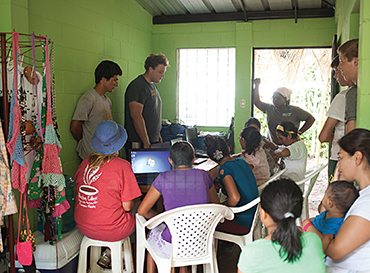
The Babson team teaches co-op members about the Internet, which many of them have no experience using. Such lessons make Alex Woodhouse ‘15 (standing, left, green shirt) appreciate his schooling. “Don’t take education for granted,” he says.
To reach new customers more easily, the leaders want to use the Internet, something they have no experience with, and the Babson team agrees to help.
A Difference Made
As the week goes on, the Babson team settles into a routine. In Ataco, the mornings start with jogs and strolls with coffee in hand, not to mention battles with the hostel shower, where the water is usually chilly, unless it’s scalding hot. During the day, the team sweats and teaches. Every night, our group eats dinner at the Portland Grill and Bar, located a few blocks from our hostel. Catering to American tastes, the restaurant serves spaghetti, hamburgers, and fries, plus Jell-O, brownies, and ice cream for dessert. During dinner one night, a discussion starts about what everyone appreciates more about home after having traveled to El Salvador. People mention warm showers, infrastructure, and education. “I think about the heavy rains we’ve had,” Thomas says, “and I think about the people who have a tarp for a roof.”

Because Taelyr Roberts ‘15 (front right) once had her own venture making and selling jewelry, she’s able to show the Getsemani artisans some new designs.
In Getsemani, the team’s work progresses. At the building site, the walls of the new house are five cinder blocks high by Friday. In the morning sessions at the co-op, the Babson team continues going over sales pitches, but it also talks of identifying one’s passion and helps the young entrepreneurs practice new jewelry designs (team member Roberts used to have her own jewelry-making business).
In the afternoon, the team introduces the co-op’s leaders to the world of computers. At first, the team has grand plans. The leaders actually have access to one old computer, so the team talks of designing the co-op a Web page and working on its social media presence. “These ladies have never turned a computer on,” Thomas says, pumping the brakes on those ideas. “We got to start with the basics. Our goal is to get them comfortable with computers.” As the ladies of the co-op huddle around several laptops supplied by the team, Woodhouse heeds Thomas’ advice. “The first thing we’re going to do is show you how to turn a computer off and on,” he says.
During the upcoming days, discussion turns to Microsoft Word, to font size and Times New Roman, and then to YouTube and Google. At one point, the team Googles “Lisa Thomas,” who is standing next to the laptops, and images of her pop up on the screen. “They were amazed,” says high schooler Fernandez.
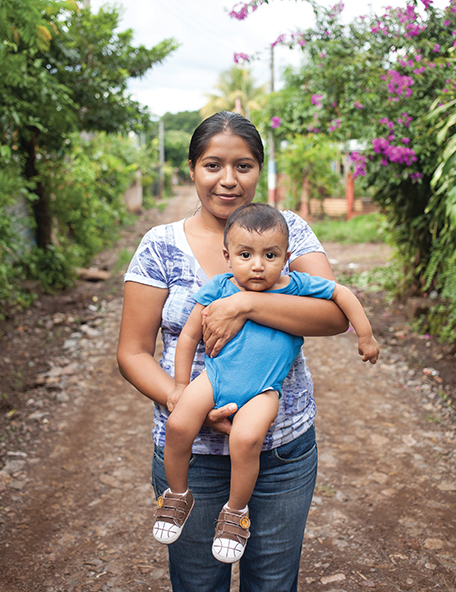
Dinora Asencio, president of the co-op’s board, holds her son, Antony. She talks of how the co-op women feel empowered by their businesses. “Besides the money our husbands bring to the home, we also bring something,” she says.
On Friday, with much accomplished, our time in Getsemani comes to a close. Habitat and the village throw us a party, complete with a cake and a band. People dance and wish us well. At the co-op, the ladies gather for a final goodbye. “Thank you for sharing your knowledge,” says Asencio, the co-op president.
With the trip winding down, I ask the four Babson students for their thoughts on all they’ve experienced. Woodhouse reflects on how much progress the co-op leaders made. “The women have done fantastic,” he says. “We grew up with computers, but they soak it up. I’m excited about what they can do with it.” Gordon-Staton is astonished that the Babson team accomplished so much with Spanish language skills that are shaky at best. “Communication is so much more than the language you’re speaking,” she says. “There is something so simple about sitting next to someone using your hands instead of your words.” And Roberts feels invigorated. “I am going to remember the cooperative, the people, and the masons,” she says. “They were awesome. They had so much life and joy. It makes me happy to be here.”
For her part, Duong ponders how much palpable change the team has made. Of course, the new house is a concrete example of the team’s efforts, but what of the teaching? Will the co-op entrepreneurs take what they learned and carry it forward? “I am a results-based person,” Duong says.

Will the young adults improve their sales pitches? Will the co-op leaders keep exploring the Internet? Thomas notes that several years ago when Babson first started with the co-op, the women were much more reserved. Now they seem confident and ambitious, and they’re striving, bit by bit, for a better life. Babson is giving them a little push to get there.
Before we leave Getsemani, we see tangible proof of Babson’s impact when we visit Isaias Garcia, who lives just down the lane from the co-op. Garcia runs a clothing business, and he shows us the back of his house—full of piles of fabric, spools of thread, and several sewing machines—which he has turned into a small factory. Three years ago, as Garcia was starting out, he came to the co-op looking for help, and a Babson team taught him some essential business skills, including inventory management and sales tracking.
Since then, his business has grown. His main customers include schools and soccer teams, and, in a typical day, the business may crank out nine dozen shirts and five dozen pants. “We’re making progress,” says Garcia. He produces the clothes along with his wife and another worker, though if he has a large influx of orders, he may hire more staff on a temporary basis. He pays his workers a quarter for every piece they make. “My country is going through a tough time,” he says. “There is a lot of unemployment. I’m happy and satisfied to give money to my people.”
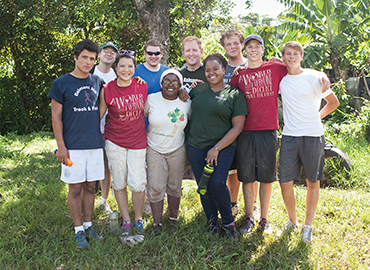
The Babson team members (minus Lisa Thomas)
Garcia admits that business can fluctuate, so he’s hoping to find customers who give him steady work. If he has a full load of orders, his workers can potentially make $15 a day. He has learned that workers in big factories might make only about $6 a day. “The big owners ask me, ‘Why do you pay so much?’” Garcia says, and he replies that he identifies with his workers. “I am one of them. I know their situations. I want to give them more. I hope my dream comes true.”
Garcia hasn’t forgotten the help the Babson team gave him. “Babson is excellent,” he says. Then he extends an invitation. “When you want to come, this is your home. My door is open to you.”
